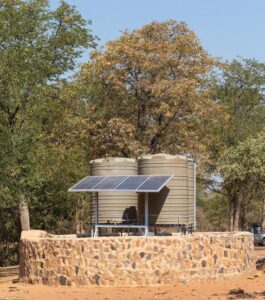How solar-powered boreholes are transforming landscapes and livelihoods



Imagine being a subsistence farmer in the Ruacana area of Namibia – if you do not live near the Kunene River, Namibia’s northwestern border with Angola, your primary water source is likely to be the local borehole. The only way to extract this water is with a diesel-driven engine. As a subsistence farmer in the mopane-dotted landscape, money is hard to come by, yet every month you must make a contribution with the rest of the community to buy diesel to power the engine and pump water for each household. Sometimes the engine breaks down and needs to be taken to far-off Opuwo for repairs, leaving the community without water for several days. Your much-valued goats and cattle cannot access this water, as it would increase diesel costs. Instead, livestock must be taken to a water point 15 or more kilometres away – a journey made even more challenging by the scorching summer temperatures, which can easily range from the mid-30s to over 40°C.
Through the Namibia Integrated Landscape Approach for Enhancing Livelihoods and Environmental Governance (NILALEG) project, communities like these have been targeted to achieve the project’s main goal of improving living standards by reducing land degradation and integrating agriculture and forestry management. The beneficiaries are part of the Ruacana landscape, one of five landscapes identified in the country’s north as part of the project. The Ruacana focal landscape features two distinct topographies and stretches over parts of the Omusati and Kunene regions.
NILALEG rehabilitated three existing boreholes in the villages of Otjovanatje, Okauapehuri and Ongete and drilled a new one in Ombambihaka. The project included the installation of solar panels, electric water pumps, water tanks, troughs and protective walls around the installations in these Ovahimba villages.
“The situation was tough because we were using a diesel pump. It was difficult to buy diesel and to go fix the engine in Opuwo. Now, with the solar system, everything is very easy. We have constant access to water, our livestock drink daily and the farmers’ association also benefits through the garden project,” says Gabriel Kajakurapo, the chairman of Ongete’s water committee.
Another initiative of the project was to set up water committees for each village. “The water committee was introduced to protect the water points at the borehole. We make sure all the livestock in the community get access to the drinking troughs and have a turn to drink water. We also ensure everything is in working order so that the community always has water,” explains Mavejaruka Tjiuma, the vice chairperson of the water committee at Okauapehuri. In addition to being a member of the water committee, Mavejaruka is a grateful member of the community whose life has been greatly improved thanks to the project. “Due to the lack of water points, we sometimes had to fetch water from other villages. It was a struggle to go about our daily activities at home, doing basic tasks like cooking. We now have a water line that runs to the village, where everyone can collect water. We can make food on time now, and it is easier to feed our children,” she says.
Not only do the households benefit, but farming practices have also been simplified. “Our animals no longer have to travel long distances for water. No one has to spend long hours with the animals in the veld searching for water. Our livelihoods are improving as we now have constant water close to the village, and our livestock numbers are increasing,” says Uaraja Kavari, the chairman of Okauapehuri’s water committee. Funded by the Global Environmental Facility through the United Nations Development Programme, NILALEG is a five-year project which was officially launched in 2020. Through the implementation of natural resource management solutions, the project has reached more than 20,000 direct beneficiaries across the five focal landscapes.
Spearheaded by the NILALEG project, that is implemented by the Ministry of Environment, Forestry and Tourism in partnership with the United Nations Development Programme and funded by the Global Environmental Facility.






